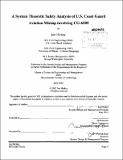| dc.contributor.advisor | Qi Hommes. | en_US |
| dc.contributor.author | Hickey, Jon (Jon Patrick) | en_US |
| dc.contributor.other | Massachusetts Institute of Technology. Engineering Systems Division. | en_US |
| dc.date.accessioned | 2013-01-23T19:43:44Z | |
| dc.date.available | 2013-01-23T19:43:44Z | |
| dc.date.copyright | 2012 | en_US |
| dc.date.issued | 2012 | en_US |
| dc.identifier.uri | http://hdl.handle.net/1721.1/76490 | |
| dc.description | Thesis (S.M. in Engineering and Management)--Massachusetts Institute of Technology, Engineering Systems Division, System Design and Management Program, 2012. | en_US |
| dc.description | Cataloged from PDF version of thesis. | en_US |
| dc.description | Includes bibliographical references (p. 150-152). | en_US |
| dc.description.abstract | During a 22-month period, between 2008 and 2010, the U.S. Coast Guard experienced seven Class-A aviation mishaps resulting in the loss of 14 Coast Guard aviators and seven Coast Guard aircraft. This represents the highest Class-A aviation mishap rate the Coast Guard has experienced in 30 years. Following each Class-A mishap, the Coast Guard conducted Mishap Analysis Boards (MAB) in accordance with Coast Guard aviation policy. A MAB involves a detailed investigation and report on the causal and contributing factors of a specific mishap and is conducted in accordance with the Department of Defense Human Factors Analysis and Classification System (DOD HFACS) which is based on the 'Swiss Cheese' accident causal analysis model. Individual MAB results did not identify common causal or contributing factors that may be causing systemic failures within the aviation safety system. Subsequently, the Coast Guard completed a more system-focused safety analysis known as the Aviation Safety Assessment Action Plan (ASAAP) comprised of five components: 1) Operational Hazard Analysis; 2) Aviation Safety Survey; 3) Aviation Leadership Improvement Study; 4) Independent Data Analysis Study; and 5) Industry Benchmarking Study. ASAAP recently concluded "complacency in the cockpit and chain of command as the leading environmental factor in the rash of serious aviation mishaps." Although the ASAAP study examined Coast Guard aviation more holistically than individual MABs, it did not apply systems theory and systems engineering approaches. This thesis applies Dr. Leveson's Systems Theoretic Accident Model and Processes (STAMP) model to identify, evaluate, eliminate, and control system hazards through analysis, design, and management procedures, in order to more fully examine the Coast Guard's aviation system for potential systemic sources of safety hazards. The case study used in this thesis is the September 2008 mishap, involving a Coast Guard helicopter (CG-6505) conducting hoist training with a Coast Guard small boat, which resulted in the loss of the helicopter and its four-person crew. The analysis identified enhancements to Coast Guard aviation system controls that were not expressly identified as part of the MAB and ASAAP study. These findings will complement the Coast Guard's MAB and ASAAP results to better understand and eliminate systemic Coast Guard aviation safety hazards with the aim of preventing future mishaps. Finally, by comparing the results of the STAMP analysis and the MAB, this thesis attempts to answer the question, 'is the STAMP model better than the 'Swiss Cheese' model in identifying causes to the accidents?' | en_US |
| dc.description.statementofresponsibility | by Jon Hickey. | en_US |
| dc.format.extent | 152 p. | en_US |
| dc.language.iso | eng | en_US |
| dc.publisher | Massachusetts Institute of Technology | en_US |
| dc.rights | M.I.T. theses are protected by
copyright. They may be viewed from this source for any purpose, but
reproduction or distribution in any format is prohibited without written
permission. See provided URL for inquiries about permission. | en_US |
| dc.rights.uri | http://dspace.mit.edu/handle/1721.1/7582 | en_US |
| dc.subject | System Design and Management Program. | en_US |
| dc.subject | Engineering Systems Division. | en_US |
| dc.title | A system theoretic safety analysis of U.S. Coast Guard aviation mishap involving CG-6505 | en_US |
| dc.type | Thesis | en_US |
| dc.description.degree | S.M.in Engineering and Management | en_US |
| dc.contributor.department | System Design and Management Program. | en_US |
| dc.contributor.department | Massachusetts Institute of Technology. Engineering Systems Division | |
| dc.identifier.oclc | 822585166 | en_US |
